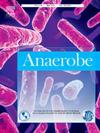A subanalysis of Clostridium perfringens bloodstream infections from a 5-year retrospective nationwide survey (ITANAEROBY)
IF 2.6
3区 生物学
Q3 MICROBIOLOGY
引用次数: 0
Abstract
Clostridium perfingens bloodstream infections (BSIs) can be associated with high mortality rates. We performed a subanalysis of all C. perfringens BSIs enrolled during a multicentric retrospective observational study (ITANAEROBY). Data were collected from January 2016 to December 2020. C. perfringens BSIs were 134 (134/1960, 6.8 %). The highest resistance rate was observed for clindamycin (26/120, 21.6 %), penicillin (11/71, 15.4 %) and metronidazole (14/131, 10.7 %). In conclusion, C. perfringens reduced susceptibility phenotype to first-line therapy.
一项为期 5 年的全国性回顾调查(ITANAEROBY)对产气荚膜梭菌血流感染的子分析。
产气荚膜杆菌血流感染(BSI)可导致高死亡率。我们对一项多中心回顾性观察研究(ITANAEROBY)中登记的所有产气荚膜杆菌 BSI 进行了子分析。数据收集时间为 2016 年 1 月至 2020 年 12 月。C.产气荚膜杆菌 BSI 为 134 例(134/1960,6.8%)。耐药率最高的是克林霉素(26/120,21.6%)、青霉素(11/71,15.4%)和甲硝唑(14/131,10.7%)。总之,产气荚膜杆菌对一线疗法的易感表型有所减少。
本文章由计算机程序翻译,如有差异,请以英文原文为准。
求助全文
约1分钟内获得全文
求助全文
来源期刊

Anaerobe
生物-微生物学
CiteScore
5.20
自引率
8.70%
发文量
137
审稿时长
76 days
期刊介绍:
Anaerobe is essential reading for those who wish to remain at the forefront of discoveries relating to life processes of strictly anaerobes. The journal is multi-disciplinary, and provides a unique forum for those investigating anaerobic organisms that cause infections in humans and animals, as well as anaerobes that play roles in microbiomes or environmental processes.
Anaerobe publishes reviews, mini reviews, original research articles, notes and case reports. Relevant topics fall into the broad categories of anaerobes in human and animal diseases, anaerobes in the microbiome, anaerobes in the environment, diagnosis of anaerobes in clinical microbiology laboratories, molecular biology, genetics, pathogenesis, toxins and antibiotic susceptibility of anaerobic bacteria.
 求助内容:
求助内容: 应助结果提醒方式:
应助结果提醒方式:


